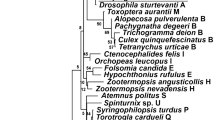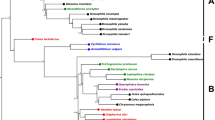Abstract
The presence and distribution of the intracellular bacteria Wolbachia in the arthropod subphylum Chelicerata (including class Arachnida) has not been extensively explored. Here we report the discovery of Wolbachia in scorpions. Five strains found in host species of the genus Opistophthalmus (Southern African burrowing scorpions) have been characterized by Multilocus Sequence Typing and by Wolbachia Surface Protein. Phylogenetic analyses indicate clustering in the supergroup F and a high genetic relatedness among all scorpion strains as a result of a potential transmission within the host genus. The F-group is an uncommon lineage compared to the A and B supergroups, although it is present in a broad range of hosts (including insects, filarial nematodes, and now arachnids) and across a large geographical area (e.g., North America, Africa, Europe, and Australia). It also shows no evidence of recombination and has a significantly higher genetic diversity than supergroup A and B. Overall, this pattern suggests an older radiation of F-strains with respect to A and B-strains, followed by limited horizontal transmission across host genera and reduced genetic flux among strains. A more extensive sampling of supergroup F-strains is required to confirm this scenario.



Similar content being viewed by others
References
Baldo L, Bordenstein S, Wernegreen JJ, Werren JH (2006) Widespread recombination throughout Wolbachia genomes. Mol Biol Evol 23:437–449
Baldo L, Dunning Hotopp JC, Jolley KA, Bordenstein SR, Biber SA, Choudhury RR, Hayashi C, Maiden MC, Tettelin H, Werren JH (2006) Multilocus sequence typing system for the endosymbiont Wolbachia pipientis. Appl Environ Microbiol 72:7098–7110
Baldo L, Lo N, Werren JH (2005) Mosaic nature of wsp (Wolbachia surface protein). J Bacteriol 187:5406–5418
Baldo L, Werren JH (2007) Revisiting Wolbachia supergroup typing based on WSP: spurious lineages and discordance with MLST. Curr Microbiol 55:81–87
Bordenstein S, Rosengaus RB (2005) Discovery of a novel Wolbachia super group in Isoptera. Curr Microbiol 51:393–398
Casiraghi M, Bordenstein SR, Baldo L, Lo N, Beninati T, Wernegreen JJ, Werren JH, Bandi C (2005) Phylogeny of Wolbachia pipientis based on gltA, groEL and ftsZ gene sequences: clustering of arthropod and nematode symbionts in the F supergroup, and evidence for further diversity in the Wolbachia tree. Microbiology 151:4015–4022
Clark MA, Moran NA, Baumann P (1999) Sequence evolution in bacterial endosymbionts having extreme base compositions. Mol Biol Evol 16:1586–1598
Cordaux R, Michel-Salzat A, Bouchon D (2001) Wolbachia infection in crustaceans: novel hosts and potential routes for horizontal transmission. J Evol Biol 14:237–243
Covacin C, Barker SC (2006) Supergroup F Wolbachia bacteria parasitise lice (Insecta: Phthiraptera). Parasitol Res 100:479–485
Floyd RM, Rogers AD, Lambshead PJD, Smith CR (2005) Nematode-specific PCR primers for the 18S small subunit rRNA gene. Mol Ecol Notes 5:611–612
Gotoh T, Noda H, Hong XY (2003) Wolbachia distribution and cytoplasmic incompatibility based on a survey of 42 spider mite species (Acari: Tetranychidae) in Japan. Heredity 91:208–216
Hartelt K, Oehme R, Frank H, Brockmann SO, Hassler D, Kimmig P (2004) Pathogens and symbionts in ticks: prevalence of Anaplasma phagocytophilum (Ehrlichia sp.), Wolbachia sp., Rickettsia sp., and Babesia sp. in Southern Germany. Int J Med Microbiol 37:86–92
Lo N, Evans TA (2007) Phylogenetic diversity of the intracellular symbiont Wolbachia in termites. Mol Phylogenet Evol 44:461–466
Martin D, Williamson C, Posada D (2005) RDP2: recombination detection and analysis from sequence alignments. Bioinformatics 21:260–262
Miller WJ, Riegler M (2006) Evolutionary dynamics of wAu-like Wolbachia variants in neotropical Drosophila spp. Appl Environ Microbiol 72:826–835
O’Neill SL, Giordano R, Colbert AM, Karr TL, Robertson HM (1992) 16S rRNA phylogenetic analysis of the bacterial endosymbionts associated with cytoplasmic incompatibility in insects. Proc Natl Acad Sci U S A 89:2699–2702
Panaram K, Marshall JL (2006) F supergroup Wolbachia in bush crickets: what do patterns of sequence variation reveal about this supergroup and horizontal transfer between nematodes and arthropods? Genetica 130:53–60
Posada D, Crandall KA (1998) Modeltest: testing the model of DNA substitution. Bioinformatics 14:817–818
Prendini L (2001) A review of synonyms and subspecies in the genus Opistophthalmus C.L. Koch (Scorpiones: Scorpionidae). African Entomol 9:17–48
Prendini L (2001) Substratum specialization and speciation in southern African scorpions: the Effect Hypothesis revisited. In: Fet V, Selden PA (eds) Scorpions 2001. In Memoriam Gary A Polis. Burnham Beeches, Bucks, UK: British Arachnological Society, pp 113–138
Prendini L (2005) Scorpion diversity and distribution in southern Africa: pattern and process. In: Huber BA, Sinclair BJ, Lampe KH (eds) African biodiversity: molecules, organisms, ecosystems. Proceedings of the 5th International Symposium on Tropical Biology, Museum Alexander Koenig, Bonn. New York: Springer Verlag, pp 25–68
Rowley SM, Raven RJ, McGraw EA (2004) Wolbachia pipientis in Australian spiders. Curr Microbiol 49:208–214
Rozas J, Sanchez-DelBarrio JC, Messeguer X, Rozas R (2003) DnaSP, DNA polymorphism analyses by the coalescent and other methods. Bioinformatics 19:2496–2497
Sakamoto JM, Feinstein J, Rasgon JL (2006) Wolbachia infections in the Cimicidae: museum specimens as an untapped resource for endosymbiont surveys. Appl Environ Microbiol 72:3161–3167
Stouthamer R, Breeuwer JAJ, Hurst GD (1999) Wolbachia pipientis: microbial manipulator of arthropod reproduction. Ann Rev Microbiol 53:71–102
Swofford DL (2002) PAUP*: phylogenetic analysis using parsimony (* and other methods), version 4.0b 10. Sunderland, Massachusetts: Sinauer Associates
Werren JH (1997) Biology of Wolbachia. Annu Rev Entomol 42:587–609
Werren JH, Windsor DM (2000) Wolbachia infection frequencies in insects: evidence of a global equilibrium? Proc R Soc Lond B Sci 267:1277–1285
Zeh DW, Zeh JA, Bonilla MM (2005) Wolbachia, sex ratio bias and apparent male killing in the16 harlequin beetle riding pseudoscorpion. Heredity 95:41–49
Acknowledgments
We thank Arati Panda for her help in sample screening. This study was supported by U.S. National Science Foundation grant EF-0328363 to JHW.
Author information
Authors and Affiliations
Corresponding author
Rights and permissions
About this article
Cite this article
Baldo, L., Prendini, L., Corthals, A. et al. Wolbachia Are Present in Southern African Scorpions and Cluster with Supergroup F. Curr Microbiol 55, 367–373 (2007). https://doi.org/10.1007/s00284-007-9009-4
Received:
Accepted:
Published:
Issue Date:
DOI: https://doi.org/10.1007/s00284-007-9009-4




